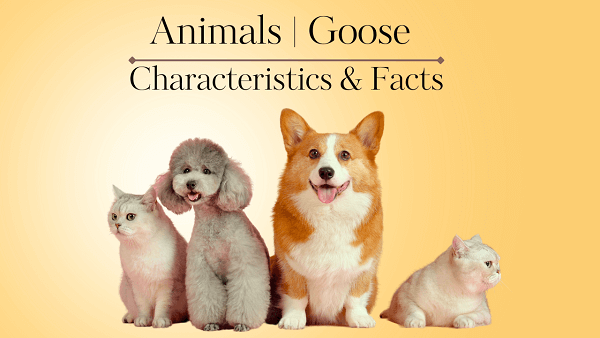
Goose Definition | Characteristics & Facts
Goose Definition
A goose is a type of bird that belongs to the family Anatidae, which also includes ducks and swans. Geese are known for their long necks, webbed feet, and large bodies. They are found in various parts of the world, both in wild and domesticated forms.
Goose General Characteristics & Facts
Appearance
Geese typically have a sturdy build with a rounded body, a long neck, and a flat, broad beak. They have strong wings and webbed feet, which make them excellent swimmers and flyers.Plumage: Geese have a variety of plumage colors and patterns, depending on the species. Some common colors include white, gray, brown, and black. Domesticated geese can also have different color variations.
Behavior
Social birds often form large flocks. Honking sounds are communication ways. Geese are known for their strong pair bonds and will often mate for life. They are also territorial and will defend their nesting sites and offspring.
Habitat
Geese can be found in a wide range of habitats, including wetlands, marshes, lakes, and grassy areas. They are adaptable birds and can live in both rural and urban environments.
Diet
Geese are herbivores and primarily feed on vegetation such as grass, leaves, stems, and grains. They graze on land and can also feed on aquatic plants by submerging their heads underwater
Migration
Many species of geese are migratory, traveling long distances between their breeding grounds in the north and their wintering grounds in the south. They form V-shaped formations during migration, which helps them conserve energy and navigate more efficiently.
Domestication
Geese have been domesticated for centuries and are commonly raised for their meat, eggs, and feathers. Domestic gorse are larger than their wild counterparts and have been selectively bred for specific traits.
Read our Animals Encyclopedia with Complete Facts
Scientific Classification of Goose
Kingdom: Animalia
Phylum: Chordata
Class: Aves
Order: Anseriformes
Family: Anatidae
Genus: Anser
Goose Physical Characteristics
- Size: Geese vary in size depending on the species. On average, geese measure between 20 to 45 inches (50 to 115 centimeters) in length and have a wingspan ranging from 4 to 6 feet (1.2 to 1.8 meters). Their weight can range from 5 to 20 pounds (2.3 to 9 kilograms), depending on the species.
- Body Shape: Geese have a sturdy and elongated body with a rounded chest. They have a long, flexible neck that allows them to reach vegetation in both water and land environments.
- Feathers: Geese are covered in feathers that provide insulation and waterproofing. Their feathers are typically a mix of soft down feathers close to the body and outer contour feathers that provide structure and protection.
- Beak: Geese have a distinctive beak that is broad and rounded at the base, gradually tapering to a point. Their beaks are adapted for grazing on grasses and other vegetation.
- Coloration: The coloration of geese varies among species. Common colors include shades of brown, gray, and white. Some species may have distinctive markings or patterns on their feathers.
- Webbed Feet: Geese have webbed feet that are designed for swimming and propelling themselves in water. The webbing helps them move efficiently and navigate through aquatic environments.
- Legs: Geese have relatively long and strong legs, positioned toward the rear of their body. They use their legs for walking on land and for taking off during flight.
- Voice: Geese are known for their distinctive honking calls, which vary in tone and intensity depending on the situation. Their vocalizations are used for communication within the flock and as a warning of potential threats.
Continue To Explore All Animals That Start With G
Key Locations of Goose
- Canada
- United States
- Russia
- United Kingdom
- China
- Germany
- Sweden
- Denmark
- Netherlands
- Australia
View All A-Z Animals List
Goose FAQs
What Goose Eats?
- Grass
- Aquatic Plants
- Grains
- Seeds and Berries
- Vegetables
How long do geese live?
Geese can live for an average of 10 to 25 years, depending on factors such as species, environment, and predation risks.
Are geese monogamous?
Yes, many species of geese are monogamous, meaning they mate for life.
Why do geese fly in a V-formation?
Geese fly in a V-formation to take advantage of the aerodynamic benefits. This formation reduces wind resistance, allows for efficient communication, and enables them to conserve energy during long-distance migrations.
How do geese communicate with each other?
Geese communicate using a variety of vocalizations, including honks, hisses, and cackles. These sounds are used for various purposes such as maintaining contact within the flock, warning of potential threats, and during courtship displays.
Are geese aggressive?
Yes! Geese can become aggressive during the breeding season or when they feel threatened.
Do geese migrate?
Yes, many species of geese are migratory birds. They undertake long-distance migrations in search of suitable breeding grounds and food sources. These migrations can span thousands of miles and often follow well-established flyways.
How do geese protect themselves from predators?
Geese rely on various defense mechanisms to protect themselves from predators. These include vocal alarm calls to alert the flock, aggressive behavior, and taking flight to escape potential threats. They may also seek refuge in bodies of water where predators have limited access.
Can geese swim?
Yes, geese are excellent swimmers. They have webbed feet and a streamlined body that allows them to navigate through water with ease. Swimming is a natural ability for geese and is used for foraging, escaping predators, and traveling.




